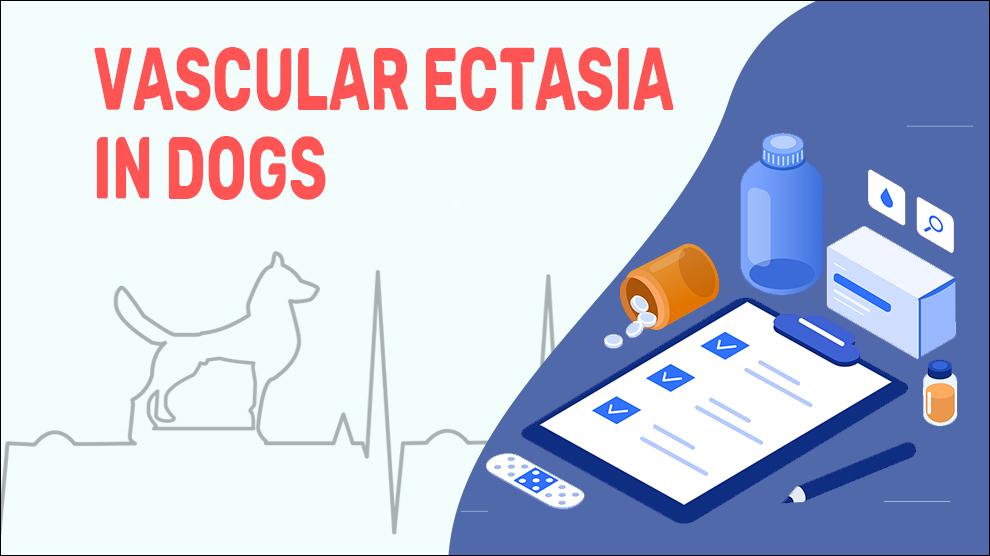What Is Vascular Ectasia In Dogs?
Vascular ectasia is a significant cause of upper gastrointestinal (GI) bleeding and it is commonly called Gastric antral vascular ectasia (GAVE) syndrome. As this is portrayed endoscopically by “watermelon stripes”- lines of red winding ectatic vessels along prolonged folds of the antral rugae, they are also known as watermelon stomach.
Although GAVE is connected with heterogeneous medical conditions, that include cardiac, hepatic, and renal diseases, its etiopathogenesis is indefinite. Usually GAVE pathogenesis is considered to be due to distorted gastric motility. The affected dogs present with unexplained blood loss causing severe acute upper gastrointestinal bleeding, chronic transfusion-dependent iron-deficiency anemia, and non-descript stomach pain.
Although GAVE syndrome is an uncommon medical condition, the possibility of occurrence in older dogs with non-variceal upper gastrointestinal blood loss is significantly higher. Rider et al first described this disease entity gastroscopically in a human patient with severe chronic iron-deficiency anemia and mentioned “blistering red changes with noticeable hypertrophic mucosal changes and copious bleeding.”
Typical histologic changes include fibromuscular hypertrophy of the lamina propria, capillary ectasia with thrombosis, and superficial hyperplastic antral mucosa. Mainly, the complications that are often connected with GAVE are not well- understood in dogs.
Symptoms Of Vascular Ectasia In Dogs
- Dehydration
- Abdominal pain
- Chronic diarrhea
- Chronic vomiting
- Hyporexia to anorexia
- Subcutaneous edema
- Ascites
- Pleural effusion
Treatment Options For Vascular Ectasia In Dogs
There is no specific treatment available for Vascular ectasia in dogs. The Treatment depends upon the underlying cause and extent/severity of the problem.
- Anti-inflammatory medications: Cyclosporine (Atopica), Cortisone (dexamethasone, prednisone, prednisolone), Azathioprine, leflunomide, and mycophenolate mofetil
- Antibiotics: Metronidazole(Flagyl), Amoxicillin/ Clavamox (Clavulanate), Chloramphenicol, Gentamicin, Tetracycline, Sulfamethoxole, etc
Home Remedies For Vascular Ectasia In Dogs
- Change to diets that cause antigenic adjustment (eg, protein hydrolysate, novel protein source).
- When dietary change gets a good response, that particular diet can be maintained for some time as long as it is balanced.
- Exclusion diet: Exclusion of ingredients that a dog has earlier encountered.
- A homemade balanced diet as an alternative to commercial diets.
How To Prevent Vascular Ectasia In Dogs?
- There are no dependable methods to prevent Vascular ectasia in dogs since it is hereditary. It is better to weed out the affected dogs when breeders think about breeding or check the roots before you get a dog from a susceptible lineage.
- Some dogs may have a stronger instinct to consume foreign objects. Keep an eye on them.
- Keep swallowable small objects out of the pet’s reach.
- Don’t leave any remnants, sharp pieces, and trash out of reach of your pets.
- Appropriately check all chew toys and stuffed animals before giving them to your dogs.
- Consult your veterinarian at once if you find any odd coughs or breathing sounds.
Affected Dog Breeds Of Vascular Ectasia
Female Dogs, Basenji, Border Collie, Boxer, German Shepherd, French Bulldog, Irish Setter, Rottweiler, Norwegian Lundehund, Soft Coated Wheaten Terrier, Weimaraner, Yorkshire Terrier
Causes And Prognosis For Vascular Ectasia In Dogs
1. Cause:
Though the symptoms of Vascular ectasia are similar to gastrointestinal dysmotility, inflammatory bowel disease (IBD), and irritable bowel syndrome (IBS). Vascular ectasia is different from IDB and IBS.
2. Mortality:
Without proper treatment, vascular ectasia can be life-threatening. The degree of the infection depends on the age, any coexisting infections, and the immune response of the host. The prognosis for GAVE is really good. Most dogs undergoing treatment will recover within a few weeks. If left untreated, GAVE can be fatal for dogs, especially for puppies, so head to your vet immediately.
3. Diagnosis:
- Gut biopsies: include mucosal biopsies of the stomach, duodenum, and/or ileal mucosa (ileoscopy)
- Computerized tomography
- Abdominal radiograph
- Gastrointestinal transit studies
- Barium small bowel series
- Antroduodenal manometry
4. Prognosis:
Early diagnosis and prompt treatment for the dogs are the ways to a better prognosis. In most cases, vascular ectasia is a temporary condition and it is manageable with appropriate treatment.
When To See A Vet For Vascular Ectasia In Dogs?
Contact your vet right away, if you notice:
- Dehydration
- Abdominal pain
- Chronic diarrhea
Food Suggestions For Vascular Ectasia In Dogs
- Bland diet: Ground Turkey/Sweet Potato/Boiled Chicken Breast + cooked rice + add-ons: Banana, pureed pumpkin, Cottage Cheese, or Scrambled Eggs.
- Plain white rice/ brown rice, barley, whole-wheat pasta, and plain white potato.
- Brown rice + skinless chicken breast(or extra-lean ground beef) + dried parsley + chopped sweet potatoes /chopped tomatoes.
- Tender calves liver/ Boiled, poached eggs + lamb chop and roast beef.
- High-fiber foods: Celery, boiled green peas, beet pulp, Wheatgerm, oats, peas, Tender cooked vegetables.
Conclusion
The recovery prospects for vascular ectasia are generally good although pathogenesis is still unknown. The most contemplated cause is hereditary in some breeds and it is good to verify the pretentious dogs when breeders consider breeding or when owners try to get a dog from an unknown ancestry.

















